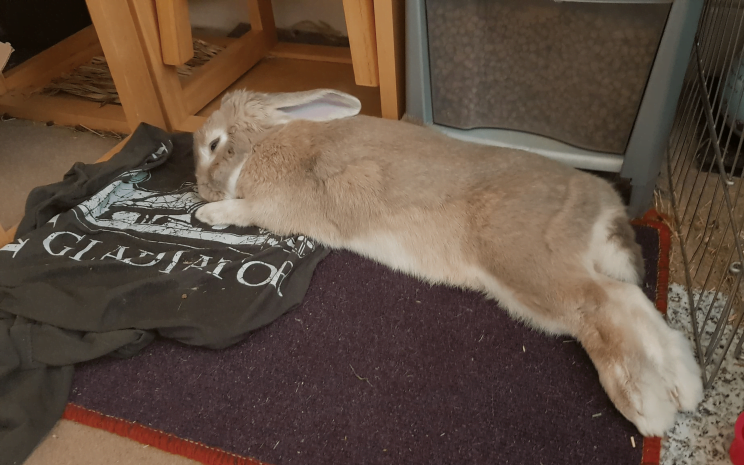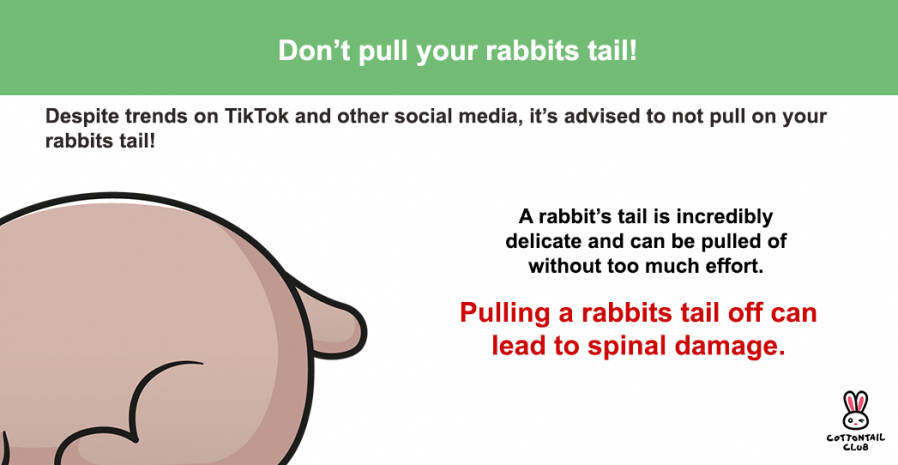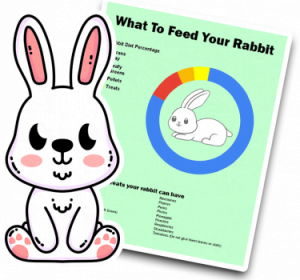
Almost all animals have tails (except for humans and apes). Their tails have evolved to serve specific functions to help animals survive and function at their best. Rabbits are no exception.
Rabbits are undeniably one of the cutest and most popular pets worldwide, and their fluffy tails are a notable part of their charm. But have you ever wondered what purpose a rabbit’s tail serves?
Or, how should you take care of it to ensure your furry friend’s well-being? In this article, we will delve into the world of rabbits’ tails and answer these questions and more.

Rabbits’ tails are vital for survival in the wild, as they help them balance and communicate with other rabbits. These functions are equally crucial for domestic rabbits, who rely on their tails to maintain their well-being and happiness.
Rabbits evolved to have tails to help them communicate with other rabbits, to help them escape predators, and allow them to maintain balance as they move. In domestic rabbits, their tails can help their owner to understand how they’re feeling and what they need through body language.
Signaling – In the wild, rabbits are a very social species. They live in large groups called colonies, in a network of underground tunnels and chambers called a warren. Within the colony, there can be hundreds of rabbits living in smaller family groups. They have a hierarchy and use body language to communicate with one another.
A rabbit’s white tail is easily seen against its darker coat. Wild rabbits use their tail to signal to other rabbits in their colony that there’s danger approaching by flicking their tail up. This allows the other rabbits to freeze, hide, or return to the warren for safety.
This is also known as altruistic behavior, meaning it’s for the more significant benefit of the group. Rabbits will warn others of danger, even if it puts them in harm’s way. They also drum with their hind legs to warn of a predator approaching.
Turning and Balancing – If you have a pet rabbit, they often turn very quickly, especially when running around. The same applies to wild rabbits. Their tail helps them to balance as they turn. The tail moves in the opposite direction as they turn to balance out their weight and ensure they can move quickly and smoothly.
Escaping Predators – Rabbits use the white of their tails to confuse predators as they run away. This helps them to escape. Their short tail also ensures predators don’t have much to grab onto.
Communicating With You – Domesticated rabbits have evolved to use their tails to communicate with their owners, so you know how they feel and what they want. Your rabbit might wag its tail if they’re annoyed or feeling stubborn.
For example, if they want a treat or don’t like the food you’ve presented them with, they might show you some attitude by wagging their tail. Sort of like a kid having a tantrum!
If your rabbit is chasing their tail, it might be bored and need more entertainment. It could also mean they want to mate or a health issue with their back end is bothering them.
| Tail Position | What It Might Mean |
|---|---|
| Wagging tail | Annoyed or being stubborn |
| Chasing their tail | Bored, want to mate, or have a potential health issue |
| Raised tail and ears back | Angry or aggressive |
| Tail down and moving slowly | Nervous or curious |
| Stretched out while lying down | Relaxed and happy |
| Tucked underbody while sitting | Relaxed and happy |
Most rabbits have white tails, especially on the underside of the tail. Since rabbits are prey animals, you might wonder why they have such a visible tail compared to their bodies! Well, the answer is that it’s thought to confuse predators.
To escape predators, rabbits run away at high speed to return to their warren or find a suitable place to hide. They often run in a zig-zag motion. While they’re running away, they often do ‘tail flagging.’ This means they raise their tail so the white underside is on display.
Research shows that this causes: “predator confusion, due to perceptual distraction from the ‘blinking tail’ stimulus emerging from the rhythmic motion of the running prey.”
Essentially, the predator sees the white tail and tries to follow it. The quick zig-zagging motion of the rabbit makes the white move quickly, making it hard to track and throwing the predator’s sense of perception off. This confusion gives the rabbit time to escape.
It’s important to note that they may not have white tails because of how domestic rabbits have been bred. There is a wide range of color variations among domesticated rabbits. Since they don’t need to escape predators in captivity, the lack of whitetails won’t affect them as it would if they were in the wild.
Are rabbit tails short? – No! We only see the end of a rabbit’s tail, which looks like a little round pom-pom or ball. However, there’s a lot more to the tail. The tail is rounded at the end and longer when stretched out or when a rabbit is relaxed.
A rabbit’s tail length can vary depending on their breed, but they tend to be between 4 and 8 cm long. If your pet rabbit is relaxed and lying stretched out, you might see its entire tail length.

In the past, a rabbit’s tail was known as a scut, which referred to the short erect tail of a rabbit, hare, or deer. The word isn’t used as often anymore, although some still prefer it.
You might even hear people use the term “scuttlebutt”, which refers to a rabbit running away from a predator. This isn’t a scientific term, but it is cute!
So, we now know that rabbits have longer tails than we might expect. Most of the time, they keep their tail in their natural position, tucked into their body. This gives that classic round ‘pom-pom’ appearance.
The tail tends to be tucked in because it evolved that way to keep them safe. A shorter tail means they can return to the warren quickly and ‘disappear’ after running away from a predator.
It also ensures a predator has nothing to grab onto, as a long tail may mean they could be caught! Their tail tucked in also helps keep it safe from accidental harm, as it’s quite fragile when stretched out.
It’s likely that in the past, rabbits with shorter tails could more easily escape predators, while rabbits with longer tails couldn’t.
So, the rabbits with shorter tails were the ones who reproduced and passed on shorter tails to their babies. The shape, size, and position of a rabbit’s tail have evolved over many years so that the rabbit can function optimally.
Your rabbit’s tail is made of a small bone connected to its spine, flesh, and fluff. It contains some small muscles and nerves to help it move.
The tail is fairly delicate and fragile, so it’s essential to be careful when handling it. Several health issues can affect your rabbit’s tail, so you must look after it well.

When they’re born, a rabbit’s tail bones haven’t hardened. They’re also born hairless and have less protection around their tail. Sometimes, tails can fracture, or bones can even become fused during development. This can cause a misshapen tail which can cause discomfort, among other issues.
Wet Tail – Some rabbits can struggle to urinate properly due to illness or injury. This can lead to urine sinking into the fur around their tail, back legs, and back end.
This isn’t just unhygienic. It can also be very uncomfortable and can irritate your rabbit’s skin. Over time, it can cause urine scald, where the rabbit’s fur falls out, and the skin is severely irritated. A long-term wet tail can cause breaks in the skin and lead to infection.
Flystrike – If your rabbit’s back end becomes particularly dirty, it can attract flies. The RSPCA explains that fly strike is: “a painful and sometimes fatal condition caused by flies laying their eggs on another animal. These hatch into maggots, which eat the flesh of their ‘hosts’.” If you see signs of flystrike, seek immediate veterinary attention.
Mats – If a rabbit isn’t able to keep themselves clean or if you don’t brush them regularly, they can develop mats (including on and around their tail). Mats aren’t just unsightly and can pull on your rabbit’s skin and be very uncomfortable.
Tail Loss – Some mothers may over-groom their babies and accidentally chew off their tails. Adult rabbits can sometimes have accidents that mean they lose their tail. Some rabbits may bite their tails off due to health issues, such as trauma, stress, or parasites. In these cases, the tail can’t grow back.
This is a severe issue in wild rabbits and could even be fatal if they can’t escape predators. This is less of an issue for domestic rabbits, and most can live happy lives without their tail.
As an owner, it’s your responsibility to make sure your rabbit is as healthy and happy as possible. There are a few ways you can take care of your rabbit’s tail to reduce the risk of health issues.
Health Checking
It’s essential to regularly check your rabbit’s health by monitoring their behavior and body for any signs of ill health. If you notice your rabbit trying to bite or scratch at their back end, it’s best to get them checked by your vet.
When you’re checking your rabbit’s back end, if you notice any of the following, make an appointment with your vet:
The sooner you catch potential health issues, the sooner they can be treated to stop them from worsening.
Cleaning
Most rabbits will clean their tail and around their back end very effectively, so you shouldn’t need to clean it very often. However, if they’re older, are overweight, have a health issue, or have long hair, you might need to clean it for them to prevent dirt from building up and causing a potential infection or flystrike.
You should also regularly clean out your rabbit’s litter and their living area to keep them healthy. It also ensures they’re happy: no one likes living in a dirty home!
Regular Brushing
Keeping up with regular brushing of your rabbit can prevent the uncomfortable mats we mentioned earlier. If you do notice a mat around your bunny’s tail, try to gently brush it out. If you can’t brush it out, you can very carefully cut the matt out so your rabbit can be more comfortable.
It’s important you don’t touch your rabbit’s tail or try to ‘stretch it out’, unless it’s for grooming or medical purposes. The tail area has lots of bones, muscles, and nerves and it can be quite sensitive. Rabbits don’t like their tails being touched and can become quite upset if you try. If you are handling your rabbit’s tail to check their health or to groom them, you should be very gentle and careful not to injure them.
We’ve learned that although rabbits’ tails are very fluffy and cute, they’re actually really important. They help rabbits to stay safe, protect themselves, and even communicate with us. Those are some pretty impressive jobs for such a small tail!
References

By entering your email address you agree to receive emails from Cottontailclub. We'll respect your privacy and you can unsubscribe at any time.